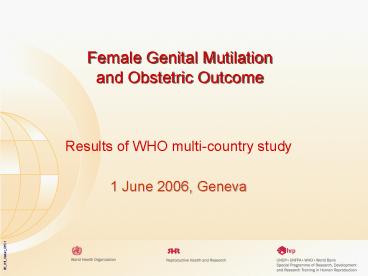Female Genital Mutilation and Obstetric Outcome - PowerPoint PPT Presentation
1 / 18
Title:
Female Genital Mutilation and Obstetric Outcome
Description:
1 June 2006, Geneva. Each year 3 million girls are forced to undergo female genital mutilation ... Patterns of risks similar in nulliparous and parous women ... – PowerPoint PPT presentation
Number of Views:454
Avg rating:3.0/5.0
Title: Female Genital Mutilation and Obstetric Outcome
1
Female Genital Mutilation and Obstetric Outcome
- Results of WHO multi-country study
- 1 June 2006, Geneva
2
Each year 3 million girls are forced to undergo
female genital mutilation
(Source WHO,1997)
3
WHO classification of FGM
- Type I Excision of the prepuce and part or
all of the clitoris - Type II Excision of the prepuce and clitoris
together with partial or total excision of the
labia minora - Type III Infubulation - Excision of part or
all of the external genitalia and stitching of
the two cut sides together to varying degrees - Type IV Pricking, piercing, incision,
stretching, scraping, or other harming procedures
on clitoris or labia, or both
4
(No Transcript)
5
Contributors
- Centres and principal investigators
- Michel Akotionga (Burkina Faso), Djibril Diallo
(Senegal), Isseu Diop Touré (Senegal), Guyo
Jaldesa (Kenya), Joseph Karanja (Kenya), Kwasi
Odoi-Agyarko (Ghana), Friday Okonofua (Nigeria),
Mairo Mandara (Nigeria), and Mohamed El Fadil
Saad (Sudan) - Study design and conception
- Emily Banks (Australia), Olav Meirik (Chile),
Oluwole Akande (Nigeria), Efua Dorkenoo (UK),
Harry Gordon (UK), Hermione Lovel (UK), Clare
McGettigan (UK), Zeinab Mohamed (UK) - Central study coordination
- Heli Bathija, Amel Fahmy, Oluwole Akande, Tim
Farley
- Data coordination
- Mohamed Ali, Annie Chevrot, Emilie Diagne,
Shereen Hasan, Alexander Peregoudov - Data analysis
- Mohamed Ali, Emily Banks, Tim Farley
- Writing group
- Emily Banks, Olav Meirik Tim Farley, Oluwole
Akande, Heli Bathija, Mohamed Ali - Steering Group
- Oluwole Akande, Mohamed Ali, Emily Banks, Heli
Bathija, Amel Fahmy, Tim Farley, and Olav Meirik
6
Aims of the study
- The primary aims of the study
- To evaluate the relationship between different
types of FGM and obstetric complications. - To estimate the incidence of obstetric
complications among women with a history of FGM
giving birth in hospital. - The secondary aim of the study
- To obtain clinical information relevant to the
prevention and treatment of obstetric
complications in women with FGM.
7
FGM study countries
8
FGM prevalence in the participating countries
- Burkina Faso 75 - 2003
- Ghana 5 - 2003
- Kenya 32 - 2003
- Nigeria 19 - 2003
- Senegal about 20
- Sudan 90 - 2000
9
Methods
- Women
- Singleton delivery at one of 28 obstetric centres
in Burkina Faso (5), Ghana (3), Kenya (3),
Nigeria (6), Senegal (8), Sudan (3) - Planned elective Caesarean sections excluded
- Consenting women examined in early labour and FGM
status determined before delivery (women in
advanced labour with expected imminent delivery
excluded)
10
- During labour and delivery the following
information was collected - Obstetric outcomes
- Duration of labour
- Mode of delivery
- Episiotomy
- Perineal tears
- Post-partum haemorrhage
- Prolonged hospitalization
- In-patient maternal death
- Newborn infants outcomes
- Vital status
- Apgar score at 5 minutes
- Anthropometric measures
11
Methods
- Statistics
- 28 509 women enrolled
- 126 (0.4) excluded for missing data on age,
parity, education, height, residence
(urban/rural) - Multivariate logistic regression, adjusted ORs
- Core factors centre, age, parity, education,
socio-economic status - Additional factors (gt5 impact on OR) height,
residence, time to reach hospital, ANC visits - Separate models for FGM I vs. no FGM, FGM II vs.
no FGM, FGM III vs. no FGM
12
Recruitment
Distribution of FGM type, by country
Country FGM 0 FGM I FGM II FGM III Total Burkina
Faso 20 23 45 13 4816 Ghana 60 11 28 1 30
94 Kenya 40 21 29 10 4167 Nigeria 12 63 24
1 5366 Senegal 21 24 54 1 3449 Sudan 18
5 5 73 7501 Total 25 24 27 23 28393
13
Women with FGM run greater risks during
childbirth
14
and so do their babies
15
Additional Results
- Patterns of risks similar in nulliparous and
parous women - Significantly higher rates of episiotomy and
perineal tears in women with FGM, though
substantial heterogeneity between centres - Estimated 10 20 additional perinatal deaths per
1000 live births in the countries where study
conducted - Complication rates likely higher in women with
limited access to obstetric services
16
Implications
- First clear evidence of obstetric sequelae
- Previous data limited and equivocal, and focussed
more on immediate complications of procedure - Clear evidence of harm for mothers and babies
- Adverse health effects of all FGM types
greatest risks with more extensive FGM - Lack of effect on birth weight yet clear adverse
effect on delivery process supports hypothesis
of mechanical problem (lack of elasticity of
cut/excised tissues?)
17
Implications
- "These results invite the authorities and health
professionals to focus - on women's rights and to ensure effective skilled
attendance during - deliveries at high risk."
- Dr Michel Akotionga,
- Principal Investigator, Burkina Faso
- "The results of this research provide empirical
data about FGM in - general and especially in women with FGM going
through labour, in - our quest to eradicate the practice of FGM
worldwide" - Dr Kwasi Odoi-Agyarko,
- Executive Director, Rural Help Integrated
- Bolgatanga, Ghana
18
(No Transcript)































